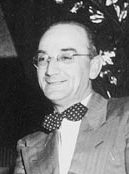
Sir Ambrose Shea was a political and business figure in colonial Newfoundland who later served as Governor of the Bahamas. He was one of two Newfoundland delegates to the Québec Conference that led to Canadian confederation.

Joseph Roberts "Joey" Smallwood was a Newfoundlander and Canadian politician. He was the main force who brought the Dominion of Newfoundland into the Canadian Confederation in 1949, becoming the first premier of Newfoundland, serving until 1972. As premier, he vigorously promoted economic development, championed the welfare state, and emphasized modernization of education and transportation. The results of his efforts to promote industrialization were mixed, with the most favourable results in hydroelectricity, iron mining and paper mills.

James Edward Quigley was a Canadian-born prelate of the Catholic Church. He served as Bishop of Buffalo, New York (1897–1903) and Archbishop of Chicago (1903–1915). Quigley spoke six languages, which made him well-equipped to supervise dioceses with a number of large and varied immigrant communities.

Sir Hugh Hoyles was a politician and lawyer who served as the third premier of the colony of Newfoundland. Hoyles was the first premier of Newfoundland to have been born in the colony, and served from 1861 to 1865. Born in St. John's, he was the son of Newman Hoyles, the first leader of the Tory Party.

Charles James Fox Bennett was a merchant and politician who successfully fought attempts to take Newfoundland into Canadian confederation. Bennett was a successful businessman and one of the colony's richest residents with interests in the fisheries, distillery and brewery industry and shipbuilding. His brother Thomas Bennett, a magistrate and member of Newfoundland's first House of Assembly, was a partner in the business.
The Conservative Party of Newfoundland was a political party in the Dominion of Newfoundland prior to confederation with Canada in 1949.

Edward Patrick Morris, 1st Baron Morris was a Newfoundlander lawyer and Prime Minister of Newfoundland.

John Joseph Glennon was a prelate of the Roman Catholic Church, serving as Archbishop of St. Louis from 1903 until his death in 1946. He was elevated to the cardinalate in 1946.

The Basilica-Cathedral of St. John the Baptist in St. John's, Newfoundland and Labrador is the metropolitan cathedral of the Roman Catholic Archdiocese of St. John's, Newfoundland and the mother church and symbol of Roman Catholicism in Newfoundland. The building sits within the St. John's Ecclesiastical District, a National Historic District of Canada.
Newfoundland, as a British colony and dominion, held 29 general elections for its 28 Newfoundland House of Assemblies. In 1934 the Dominion of Newfoundland surrendered its constitution to the Crown and ceased to have a legislature in order to be ruled by London through the Commission of Government.

John Joseph Cantwell was the first archbishop of the Roman Catholic Archdiocese of Los Angeles.

The Newfoundland Referendums of 1948 were a series of two referendums to decide the political future of the Dominion of Newfoundland. Before the referendums, Newfoundland was in debt and went through several delegations to determine whether the country would join Canada, remain under British rule or regain independence. The voting for the referendums occurred on June 3 and July 22, 1948. The eventual result was for Newfoundland to enter into Confederation.
John William Shaw was an American clergyman of the Roman Catholic Church. He served as Bishop of San Antonio (1911–1918) and Archbishop of New Orleans (1918–1934).

The Roman Catholic Archdiocese of Sydney is a Latin Church metropolitan archdiocese located in Sydney, New South Wales, Australia.

The history of Newfoundland and Labrador covers the period of time from the arrival of the Archaic peoples, Prior to European colonization, the lands encompassing present-day Newfoundland and Labrador were inhabited for millennia by different groups of indigenous peoples.
Joseph Patrick Hurley was an American prelate of the Roman Catholic Church. He served as Bishop of St. Augustine from 1940 until his death in 1967. He also held diplomatic posts in Europe and Asia.

The Canadian province of Newfoundland and Labrador is governed by a unicameral legislature, the House of Assembly, which operates under the Westminster model of government. The executive function of government is formed by the Lieutenant Governor, the premier and his or her cabinet. The politics of Newfoundland and Labrador is defined by a long history, liberal democratic political institutions and a unique political culture.

The Fishermen's Protective Union was a workers' organisation and political party in the Dominion of Newfoundland. In many ways, the development of the FPU matched that of the United Farmers movement in parts of Canada.

Edward Joseph Hanna was an American clergyman of the Roman Catholic Church. He served as Archbishop of San Francisco from 1915 to 1935.
Malcolm Mercer Hollett was a Newfoundland magistrate, politician and Canadian Senator.















